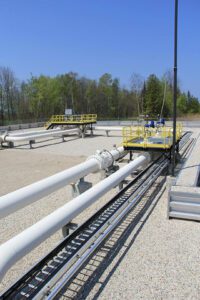Millions and millions of miles of pipelines crisscross the United States to transport large quantities of energy sources and commodities. These commodities serve a number of our everyday needs such as transportation, heating our homes, manufacturing, and agriculture. Products transported in pipelines include crude oil, refined petroleum products such as gasoline and diesel fuel, highly volatile liquids such as propane and ethane, and natural gas.
large quantities of energy sources and commodities. These commodities serve a number of our everyday needs such as transportation, heating our homes, manufacturing, and agriculture. Products transported in pipelines include crude oil, refined petroleum products such as gasoline and diesel fuel, highly volatile liquids such as propane and ethane, and natural gas.
Pipelines are considered to be one of the safest and most efficient means of transporting commodities used to power our homes and businesses. However, as the nation’s demand for oil and gas grows and our pipeline infrastructure ages, we must start to look more closely at the pipelines that lie buried beneath us and the potential risks they pose to our water resources.
Types of Pipelines
There are two main categories of fuel pipelines: Hazardous Liquid and Natural Gas.
Hazardous Liquid Pipelines
Hazardous liquid pipelines transport crude oil; refined petroleum products which includes gasoline, diesel, jet fuel, and home heating oil; highly volatile liquids or natural gas liquids (NGLs) which is butane, ethane, and propane; carbon dioxide; and anhydrous ammonia.
There are essentially two major types of hazardous liquid pipelines: gathering lines and transmission lines.
- Gathering pipelines gather crude oil from production wells and move it to central gathering facilities. From there, crude oil is transported from the gathering facilities to refineries, the facilities that convert the crude oil into petroleum products through various refining processes.
- The largest pipelines are called transmission lines and they transport the crude oil and other products across the country. These pipelines can extend tens to thousands of miles and cross state and continental borders.
The pipe used in oil pipeline systems can range in size from 2 inches to 42 inches in diameter. Powerful pumps spaced along the pipeline push the liquid through the pipe at approximately 3 – 8 miles per hour.
Many hazardous liquid pipelines transport different types of commodities in the same pipeline. To do so, the pipeline operator sends different products in “batches,” where each batch of liquid is pushed along at the same speed along the pipe.
Natural Gas Pipelines
Natural gas pipelines transport natural gas which is primarily methane (94%), 4% ethane, and 2% other gases including carbon dioxide and butane. Almost all natural gas is shipped by pipeline to end users.
There are essentially three major types of natural gas pipelines: gathering lines, transmission lines, and distribution lines. Gathering pipelines gather raw natural gas from production wells and transport it to a gas processing facility, where water and other impurities are removed. Once cleaned at the processing facility, natural gas is transported via transmission lines thousands of miles across many parts of the continental United States. Once the natural gas reaches its destination, it is distributed through natural gas distribution pipeline systems to our homes and businesses through mains and service lines.
The pipe used in natural gas pipeline systems can range in size from 2 inches to 42 inches in diameter; except for gas service lines which are generally from ½ inch to 2 inches in diameter. Natural gas gathering and transmission pipeline systems are constructed from steel pipe. However, natural gas distribution systems have been constructed from many different materials including cast iron, steel, copper, and plastic – which is the most commonly used material today.
Pipeline Mileage
There are approximately 2.7 million miles of pipelines that stretch across the U.S. to transport approximately 65% of the energy we consume.
As of September 2015, the majority of these pipelines are for gas distribution (81 percent). Another 318,969 miles of pipeline are used for gas transmission and gathering, which is 12 percent of the total. The remaining miles, 208,712 miles or seven percent of the total, are used to transport hazardous liquids.
Up-to-date pipeline mileage statistics are available at www.phmsa.dot.gov/pipeline/library/data-stats/pipelinemileagefacilities.
Pipeline Markers
Permanent signs, called pipeline markers, are placed along pipeline routes to identify the general location of a pipeline. Markers and warning signs are located at frequent intervals along transmission and liquid pipeline rights-of-way (ROW). They are found where a pipeline intersects a street, highway, railway, waterway, and at other prominent points along the route.
Markers can vary in size, shape, and color, but all markers include important information about the pipeline including the product transported, the pipeline operator’s name, and the operator’s emergency contact number to report pipeline problems. However, line markers do not indicate the depth of the line, the number of lines in the area, or the exact location of a pipeline.

